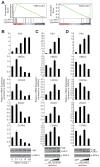Androgen receptor splice variants mediate enzalutamide resistance in castration-resistant prostate cancer cell lines
- PMID: 23117885
- PMCID: PMC3549016
- DOI: 10.1158/0008-5472.CAN-12-3630
Androgen receptor splice variants mediate enzalutamide resistance in castration-resistant prostate cancer cell lines
Abstract
Persistent androgen receptor (AR) transcriptional activity underlies resistance to AR-targeted therapy and progression to lethal castration-resistant prostate cancer (CRPC). Recent success in retargeting persistent AR activity with next generation androgen/AR axis inhibitors such as enzalutamide (MDV3100) has validated AR as a master regulator during all stages of disease progression. However, resistance to next generation AR inhibitors limits therapeutic efficacy for many patients. One emerging mechanism of CRPC progression is AR gene rearrangement, promoting synthesis of constitutively active truncated AR splice variants (AR-V) that lack the AR ligand-binding domain. In this study, we show that cells with AR gene rearrangements expressing both full-length and AR-Vs are androgen independent and enzalutamide resistant. However, selective knock-down of AR-V expression inhibited androgen-independent growth and restored responsiveness to androgens and antiandrogens. In heterogeneous cell populations, AR gene rearrangements marked individual AR-V-dependent cells that were resistant to enzalutamide. Gene expression profiling following knock-down of full-length AR or AR-Vs showed that AR-Vs drive resistance to AR-targeted therapy by functioning as constitutive and independent effectors of the androgen/AR transcriptional program. Further, mitotic genes deemed previously to be unique AR-V targets were found to be biphasic targets associated with a proliferative level of signaling output from either AR-Vs or androgen-stimulated AR. Overall, these studies highlight AR-Vs as key mediators of persistent AR signaling and resistance to the current arsenal of conventional and next generation AR-directed therapies, advancing the concept of AR-Vs as therapeutic targets in advanced disease.
Figures




Comment in
-
Words of wisdom. Re: androgen receptor splice variants mediate enzalutamide resistance in castration-resistant prostate cancer cell lines.Eur Urol. 2013 Jul;64(1):169-70. doi: 10.1016/j.eururo.2013.04.024. Eur Urol. 2013. PMID: 23746320 No abstract available.
-
Words of wisdom: re: androgen receptor splice variants mediate enzalutamide resistance in castration-resistant prostate cancer cell lines.Eur Urol. 2013 Aug;64(2):339-40. doi: 10.1016/j.eururo.2013.05.012. Eur Urol. 2013. PMID: 23830228 No abstract available.
References
-
- Scher HI, Fizazi K, Saad F, Taplin ME, Sternberg CN, Miller MD, et al. Increased Survival with Enzalutamide in Prostate Cancer after Chemotherapy. N Engl J Med. 2012;367:1187–97. - PubMed
Publication types
MeSH terms
Substances
Grants and funding
LinkOut - more resources
Full Text Sources
Other Literature Sources
Medical
Molecular Biology Databases
Research Materials

